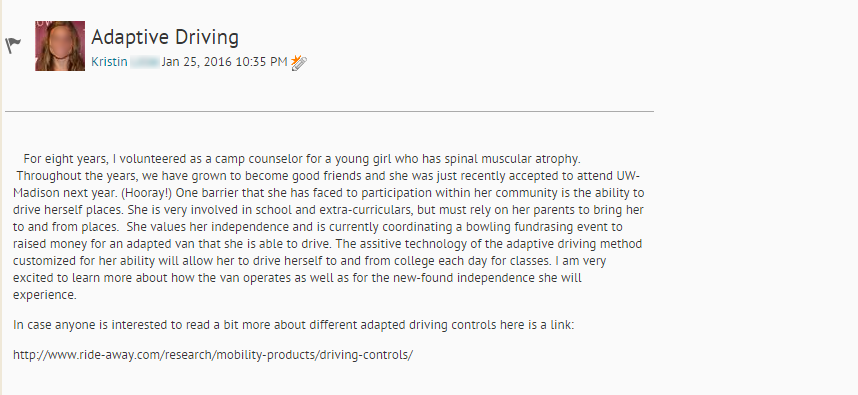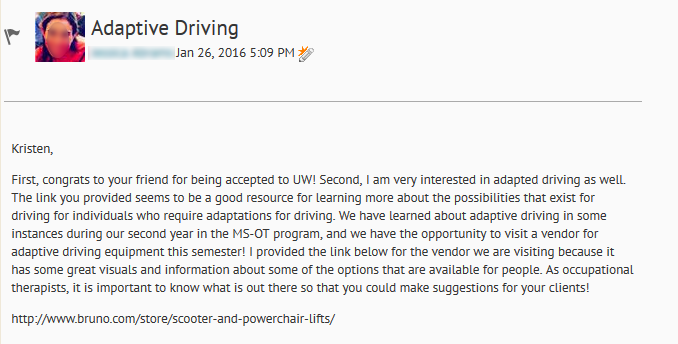
D2L Discussion Forum
Name, Abbreviation, and Number of Course
Kinesiology (KINES) 508: Assistive Technology in Practice
Name of Activity or Assignment
Getting Started and Module 1 Discussion Forums in the Content Management System (CMS)
Description and Purpose of Engagement Tool
The D2L Discussion Tool is an asynchronous communication forum where students can post introductions, answer assigned questions about course readings, ask questions about content students don’t understand, and state any problems they might be having with D2L. Students can also read and respond to questions or comments in the Discussion area from instructors or their peers, share files, and complete assigned group work from the Discussion area.
The Discussion Forum extends learning and provides an opportunity for deeper learning and understanding as well as providing a sense of community for the learner. As it is directly in the CMS, there is a smaller learning curve –if any, as many students will have already used this Content Management System.
The faculty responds to the students and checks in regularly, thereby establishing a presence in the course.
Description and Purpose of Activity or Assignment
A number of Activities and information are included in the Module 1 Discussion Forum. There are short guidelines for posting to the forums that inform and direct the student to additional rubrics to help them provide optimal responses to the questions, and to their peers. These are designed to give the students an understanding of what needs to be done to be successful in the discussion portion of their participation grade.
Raise Your Hand
Raise Your Hand is an area provided for the students that may address questions or concerns outside of the course, and serves to provide a safety net for students with various abilities. It also includes directions for posting in case students are new to the process or unfamiliar with it.
Class Cafe: A Place for Sharing
The Class Café is designed to create a place where casual conversations can take place between classmates. The Class Café allows students to connect and network with their fellow students outside of the classroom context. To get started faculty first ask students to introduce themselves to the class as an Ice Breaker, with no grade assessed. This allows the student to become familiar with the discussion tool. More specific questions can be asked that tie the student to the reason they are in the course, asking them to think about their intrinsic motivation for taking the course or why they have chosen their particular major.
The “Tell Us About You” section is designed to build a sense of online community that helps foster connection and aids in student retention and completion rate (Palloff & Pratt, 2007, pp 48-52).
AT History and Framework (Mandatory)
As the Getting Started/getting acquainted with the tool activates are part of the initial module, there is also a content specific question or questions for the student related to the focus of the course. These questions could be very detail or they can be more generalized, but the intent is to move the student form the casual experience of using the discussion tool, to focusing on course specific content as a means of assessment.
Directions for posting and expanding the posts to include classmates or teammates via response should also be included here to establish a community of learning. Discussions should be set up based on the rhythm of the course. In doing this, the student will begin to realize there is a pattern to the way he/she can navigate the course on a weekly, monthly, module or unit basis. This helps them in that they do not have to continually check for details of when various course components are due.
Learning Objectives Associated with Engagement Tool
- Briefly describe the history of AT development and application.
- Discuss current concepts of functioning, disability and health.
- Identify populations that may benefit from AT
- Distinguish between the components of an AT service delivery framework.
Preparation Details of Activity or Assignment
With the exception of the “Raise Your Hand” and the initial “Tell Us About You” discussion topics, the remaining topics all require responses from students in in the course in order for students to “connect” to one another and establish a learning community.
This course is comprised of undergraduates, graduate students, and professionals in the field, so groups were assigned before the required discussions were posted in order to have smaller communities, that are more closely related in terms of experience and education. For Discussions, there is no Group Assessment; students become part of a group only in terms of the above criteria. The Discussion is directly related to the course material, creating an opportunity to reflect upon what they’ve learned. By asking various question the student are provided an opportunity to think more deeply and critically about the course content provided.
The Students are assigned Discussion Groups that are posted in the News Item the first week of class.
Student Instructions for Activity or Assignment
Part 1: Answer the Discussion Question(s).
Part 2: Read and respond to a minimum of two other students' responses (try and comment on someone who has fewer responses). Feel free to respond to others as you'd like.
Please see the Discussion Guidelines.
Assessment/Grading Criteria for Activity or Assignment
Students will be graded on their participation in online class discussions. The discussions will be worth 30% of the grade.
For information about discussion requirements, assessment, and submission, please refer to the Discussions section of the About page. The format below will serve as a standard for a semester.
Please see the Discussion Rubric.
Grading Criteria & Value:
Point Value |
Grading Criteria |
3 |
Posting of the initial response by the appropriate deadline |
3 |
Responding to at least 2 postings |
3 |
6 possible points @ 5 weeks = 30 points |
Example of Final Student Output
The images below are from the "Tell Us About You" Discussion section from the student, with response from faculty.


AT History and Framework (Mandatory)
- Share with the rest of the group one situation you have observed or experienced that demonstrates the mismatch between a particular individual's abilities and the environment required for that person to fully participate in home, community, school or work. Can you identify a current technology or describe the type of technology that would have to be invented or designed to support this individual's full participation?
- Share with your group a little more about your particular interest in Assistive Technology. For those of you who are full-time students that are not currently working with a client population, you may project to what you think you will be doing in 5 or 10 years. What populations do you serve? What are their primary needs for AT? Where do you serve them? Why are you providing services? How do you determine which services will be most beneficial to your population of students/clients?
- Write your first response no later than the Wednesday BEFORE the Module and Discussion closes.
- Respond to 2 of your classmates no later than the Friday BEFORE the Module and Discussion closes.



References
Palloff, R. M. & Pratt, K. (2007). Building online learning communities: Effective strategies for the virtual classroom.